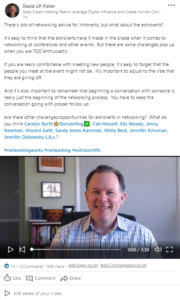 The coronavirus pandemic has had an impact on every part of our business communication. And professional networking hasn’t avoided the crunch.
The coronavirus pandemic has had an impact on every part of our business communication. And professional networking hasn’t avoided the crunch.
Ironically, these many obstacles to connecting have appeared at a time when engagement and support are more important than ever.
But just because there are challenges to getting together in person, you don’t have to stop your networking activities. In fact, there is a lot of value to be found in continuing to grow and cultivate your network with colleagues, prospects, and partners while stuck at home.
How I Kept Networking During Self-Isolation
I try to be “evergreen” in a lot of my writing and focus on principles that apply across a large spectrum of experiences. But I think there are general ideas that can be gleaned from my activities during this very specific (and hopefully short-lived) time of self-isolation.
I live just outside of Chicago, and our first Illinois shelter-in-place order came on March 20th, 2020. And we’ve been working with some version of it in place through the rest of the summer.
So my Chicago network has had to wrestle with how to stay connected during a time when we’re usually at our most social. This is usually the season for outdoor happy hours, patio meetings, company picnics, and golf events.
Not this year.
And that goes for others across the country and the globe.
 “What is certain is that nothing is certain in 2020. Some days it seems as if we are trying to connect while we’re all walking on shaky ground surrounded by spots of quicksand. This is why having an authentic approach where you connect as human first is so important. It feels off to just jump into business “as usual” when the world seems on fire around us sometimes.”
“What is certain is that nothing is certain in 2020. Some days it seems as if we are trying to connect while we’re all walking on shaky ground surrounded by spots of quicksand. This is why having an authentic approach where you connect as human first is so important. It feels off to just jump into business “as usual” when the world seems on fire around us sometimes.”
-Carolyn Barth, Digital Content Strategy LLC
Find Your Own Networking Strategy
 I don’t know if there is a “perfect” way to network in the midst of the global pandemic. There are so many variables to factor in. People have different personalities, goals, preferences, and careers that all influence the best approach to take.
I don’t know if there is a “perfect” way to network in the midst of the global pandemic. There are so many variables to factor in. People have different personalities, goals, preferences, and careers that all influence the best approach to take.
But that was true even before the arrival of coronavirus and its impact. There have always been many different ways to approach building, cultivating, and leveraging business relationships. What works for one person might not feel comfortable for someone else.
The uncertainty and stress of the pandemic has compounded those variables. Everyone had, and continues to have, a different experience of the pandemic and a different reaction to it. So don’t think that there’s just one checklist that you have to complete if you want to continue networking.
That being said, when I look at what I’ve been doing the past few months, there were approaches I took that helped. They enabled me to reach out to my network in a meaningful way while still stuck at my dining room table (my temporary office).
7 Keys to My Pandemic Networking
To keep the networking pipeline moving forward, here’s what I did:
1. Continued to Engage
The biggest decision I made was to continue to include networking in my weekly schedule. That wasn’t necessarily a given, considering the uncertainty at the beginning of the quarantines in various places. (Remember the hunt for toilet paper in March?)
I made the conscious decision to keep up my focus on building my business relationships. It took a back seat for the first few weeks as we adjusted to my wife working from home and a new child care set-up, but I still made sure to spend time on LinkedIn and 1:1 video calls.
2. Leveraged Video Calls for 1:1 Conversations
Zoom fatigue is real, but Zoom has given us an invaluable tool to continue to connect. We’ve been able to have birthday parties, happy hours, conferences, and so much more. And for me, it’s been a key tool in continuing to build my relationships.
Meeting someone for lunch, coffee, or a cocktail has been a central part of my networking process, both for establishing new relationships and cultivating existing ones. A video call isn’t as good as being with the other person, but it has a much bigger impact than a phone call. I’ve continued to have between three and five video calls with my network every week.
 “Video networking has helped me really get to know connections I used to only connect with every few months. Video allows me to see them and how they are handling the changes, ask if I can help, and gain advice on keeping my own work running smoothly. For me, the time spent with friends and colleagues that I already knew has provided the most support and the most innovative thinking on how to deal with our new normal.”
“Video networking has helped me really get to know connections I used to only connect with every few months. Video allows me to see them and how they are handling the changes, ask if I can help, and gain advice on keeping my own work running smoothly. For me, the time spent with friends and colleagues that I already knew has provided the most support and the most innovative thinking on how to deal with our new normal.”
-Heather Bennett, Creative Brand Coach
3. Increased my Focus on LinkedIn
 I was already active on LinkedIn, but I intentionally made more time and space for having conversations there. I don’t think social media is a perfect replacement for in-person events, but it is better than being completely cut-off.
I was already active on LinkedIn, but I intentionally made more time and space for having conversations there. I don’t think social media is a perfect replacement for in-person events, but it is better than being completely cut-off.
I had access to LinkedIn Live, so starting in mid-March I delivered a 20-30 minute training session each weekday (it lasted for eleven weeks). I kept up the same amount of posting as usual (once a day). And I commented and engaged with the posts from my network a lot more. My goal was to keep conversations, even short social media ones, happening.
4. Selected a Few Online Group Events to Attend

The simple truth is that offline group events don’t automatically transform into great online events. Happy hours, conferences, networking meetings…they all require some of the serendipitous freedom of the in-person to work. So when I was going to attend events online, I was picky.
The biggest thing I looked for was some sort of active moderation. Having 10 people in a Zoom room doesn’t work unless someone can keep the conversation focused and ensure that everyone is included. And anything above 10 people meant that it was going to be logistically challenging for networking.
 “At the beginning of shelter-in-place, I committed to creating a safe space for inspiring, actionable conversation when my network needed it most. My Harmony Insights Lunch Dates have allowed me to remain engaged with my audience, top of mind with potential clients, and hyper-responsive to the many, often unanticipated, ways in which I can be of service to others.”
“At the beginning of shelter-in-place, I committed to creating a safe space for inspiring, actionable conversation when my network needed it most. My Harmony Insights Lunch Dates have allowed me to remain engaged with my audience, top of mind with potential clients, and hyper-responsive to the many, often unanticipated, ways in which I can be of service to others.”
-Erich Kurschat, Harmony Insights
5. Focused on my Existing Network
I think it’s harder to start new relationships over digital tools. It’s not impossible, but you have to put more effort into building up the trust with someone when you can’t share a physical space with someone.
But most of us have existing networks of people that we have only a superficial relationship with. Or there are people that we haven’t talked to in years. So instead of worrying about adding new people into my network, I’ve spent most of my attention on existing connections. I’ve been deliberate to reach out to people who I haven’t spoken to in a while to check in.
6. Connected as a Human
Most of my conversations with my network have started with the question, “How are you doing?”. That’s not small talk. It’s not a filler. It’s the main reason that I’m in the conversation. Because the pandemic and it’s ensuing economic chaos have had such a varied and dramatic impact on people’s lives, I don’t want to assume anything.
I want to connect with them on a human level. This has also been key for my own psychological well-being. There’s a common refrain that “we’ll get through this together”. For that to work, we actually have to connect and communicate together. And that is what networking has been for me.
 “I always start networking conversations with a non-business touch rather than just jumping into the business agenda. I think having this human touch is what makes me want to have more and more of these conversations. I am always learning about cool new ideas, resources, and activities from my network. I wouldn’t know about them if it wasn’t for this personal engagement in the beginning of my conversations.”
“I always start networking conversations with a non-business touch rather than just jumping into the business agenda. I think having this human touch is what makes me want to have more and more of these conversations. I am always learning about cool new ideas, resources, and activities from my network. I wouldn’t know about them if it wasn’t for this personal engagement in the beginning of my conversations.”
-Daleele Alison, RooksDM
7. Take Breaks When I Needed Them
Let me be clear. This time has been exhausting for me as it has for others. The list of stressors right now is a mile long, and some days everything just seems to pile up. And if you are doing networking right (by being intentional and deliberate), it can just add to that exhaustion.
So I’ve also given myself permission to not network when I don’t want to. That might be for a day, or it might be longer (I took two weeks off in the beginning of June and it completely reset my outlook). Be aware of where you are and be honest with yourself about your mental health. Network as much or as little as makes sense.
How to Manage Future Uncertainty
There is rarely a time when things are completely certain. But there has rarely been a time when so much uncertainty exists in world.
Your network can’t make that uncertainty disappear, but it can help you navigate it.
Continue to spend time and attention on your relationships, and you will be well-served.
We’ll get through this…together.
